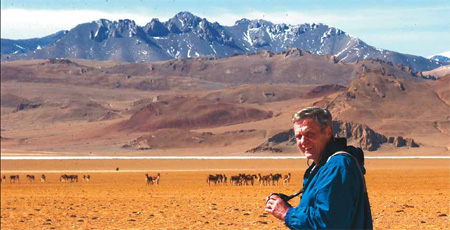60 People, 60 Stories
Life's work
(China Daily)
Updated: 2009-09-30 10:00
|
 George Schaller tracing the footsteps of large herds of Tibetan wild ass in Chang Tang National Nature Reserve in Tibet. [China Daily] |
| ||||
But for zoologist George Schaller, 1972 was the year he first thought of studying giant panda and their habitat in western China. Now 76, he shows no sign of retiring from that work.
In 1972, Schaller was working in Pakistan for the World Wildlife Fund (WWF, now the World Wide Fund for Nature). While traveling in a WWF van, he met several Chinese workers, who showed obvious familiarity with the logo of a giant panda, which was painted on the van.

While WWF chose the giant panda as its logo in 1961, little was known about "the big furry animal with her appealing, black-patched eyes", Schaller recalls.
The giant panda is indigenous only to China. At that time, no one knew how many there were in the wild, what their habitat was, or what condition it was in.
Schaller went to the Chinese embassy in Islamabad to discuss the possibility of going to China to study pandas, "but they were not ready", he says.
He waited, never giving up hope.
When news about China's opening up spread worldwide in 1979, Schaller again put forward his panda project.
Soon the Chinese government agreed to collaborate with WWF on a panda research project. Since then, Schaller has come to China almost every year, spending weeks or even months in the forest and pastures of the Qinghai-Tibet Plateau or the alpine meadows connecting China's Xinjiang with other Central Asia countries.
In nearly 30 years, Schaller has introduced the ecological systems and big-hoofed wildlife of the remote northern and western areas of China to the world.
"One has the obligation to animals and plants for protecting the environment," he says.
Accompanied by Chinese scientists, he has pursued the goal of conservation through many twists and turns.
When Schaller officially started his panda research as a WWF expert in Wolong, Sichuan, his job was to "introduce our Chinese co-workers to new technology, ideas, and techniques", he says in his book, The Last Panda, published in 1994.
Although China set up its first nature reserve in Guangdong in 1956, wildlife studies were few and far between. To study the giant panda in the wild, Schaller and his Chinese colleagues had to start gathering basic information on the animal first.
On May 15, 1980, he first walked into a forest inhabited by giant pandas. "Although I did not see pandas that day, I did find their droppings and examined sites where they had fed on bamboo," he recalls in The Last Panda. "I was in Wolong for two months before I saw a panda in the wild."
While Schaller and his Chinese colleagues conducted an inventory, they discovered problems that threatened the survival of the pandas and other wildlife. These included poaching, poor forest management, and destruction of habitat.
Despite initial success, he found it difficult to accomplish what he had set out to do. When Schaller raised questions with Chinese biologists about wildlife and ecology in China, "they looked at me and didn't know what I was talking about," he says.
But a series of droughts and floods, especially severe floods that hit most of the provinces and autonomous regions in China in 1998, served as a wake-up call. Continuous logging had not only caused soil erosion but also raised the incidence and severity of floods and landslides.
In late 1998, the State Council issued regulations banning commercial logging in all mountainous areas of western China. Th government also subsidized farmers to convert farmland on slopes of greater than 25 degrees to shrubs and woods. Since 1996, the acreage of national and local nature reserves has doubled and now accounts for 15 percent of the nation's land mass.
Schaller says that large-scale logging and poaching have almost stopped, and that conditions for pandas have improved "tremendously". Despite progress being made in many areas, however, "the minute you improve something, new problems emerge", he says.
Over-population of the Tibetan wild ass now poses problems in some villages in Tibet, as a result of stringent protective measures.
Overgrazing is another problem as economy booms. Some traditional ways of life, such as herding, are also disappearing. Many children now go to boarding school and no longer learn herding at home. Their fathers now drive motorbikes to and from the pastures where their livestock feed.
"The whole economy is changing, posing challenges for conservation," Schaller says.
Above all, global warming is having a huge impact on the Earth's wildlife, Schaller says. In western China, as glaciers retreat, less water flows down the mountainsides and alpine meadows, pastures, and grassland suffer from drought.
"You can never relax," Schaller says.








